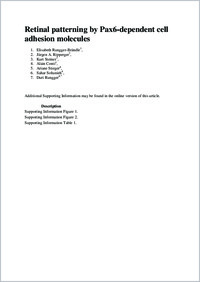Retinal patterning by Pax6-dependent cell adhesion molecules
- Rungger-Brändle, Elisabeth Cell Biology Laboratory, University Eye Clinic, HUG, Geneva, Switzerland
- Ripperger, Jürgen A. Department of Biochemistry, University of Fribourg, Switzerland
- Steiner, Kurt Institute of Molecular Life Sciences IMLS, University of Zurich-Irchel, Switzerland
- Conti, Alain Cell Biology Laboratory, University Eye Clinic, HUG, Geneva, Switzerland
- Stieger, Ariane Station de Zoologie Expérimentale, University of Geneva, Switzerland
- Soltanieh, Sahar Station de Zoologie Expérimentale, University of Geneva, Switzerland
- Rungger, Duri Station de Zoologie Expérimentale, University of Geneva, Switzerland
-
18.08.2010
Published in:
- Developmental Neurobiology. - 2010, vol. 70, no. 11, p. 764–780
English
Long-standing evidence gained from Pax6 mutant embryos pointed to an involvement of Pax6-dependent cell adhesion molecules in patterning the central nervous system and, in particular, the retina. However, direct evidence for such pathways remained elusive. We here present direct evidence that knockdown of Pax6 expression by morpholino antisense molecules in Xenopus embryos and knockdown of maternal N-cadherin (mNcad), N-cadherin (Ncad) and neural cell adhesion molecule (NCAM) produce similar phenotypes. Eye formation is reduced and retinal lamination is heavily disorganized. In Pax6 knockdown embryos, the levels of mRNAs coding for these cell adhesion molecules are markedly reduced. Overexpression of Pax6 efficiently rescues the phenotype of Pax6 knockdown embryos and restores expression of these putative target genes. Rescue of Pax6-deficiency by the putative target gene mNcad moderately rescues eye formation. The promoters of the genes coding for cell adhesion molecules contain several putative Pax6 binding sites, as determined by computer analysis. Chromatin immunoprecipitation shows that, in embryonic heads, Pax6 binds to promoter regions containing such predicted binding sites. Thus, several cell adhesion molecules are direct target genes of Pax6 and cooperate in retinal patterning.
- Faculty
- Faculté des sciences et de médecine
- Department
- Département de Biologie
- Language
-
- English
- Classification
- Biological sciences
- License
- License undefined
- Identifiers
-
- RERO DOC 21115
- DOI 10.1002/dneu.20816
- Persistent URL
- https://folia.unifr.ch/unifr/documents/301906
Other files
Statistics
Document views: 62
File downloads:
- rip_rpp.pdf: 170
- rip_rpp_sm.pdf: 97

